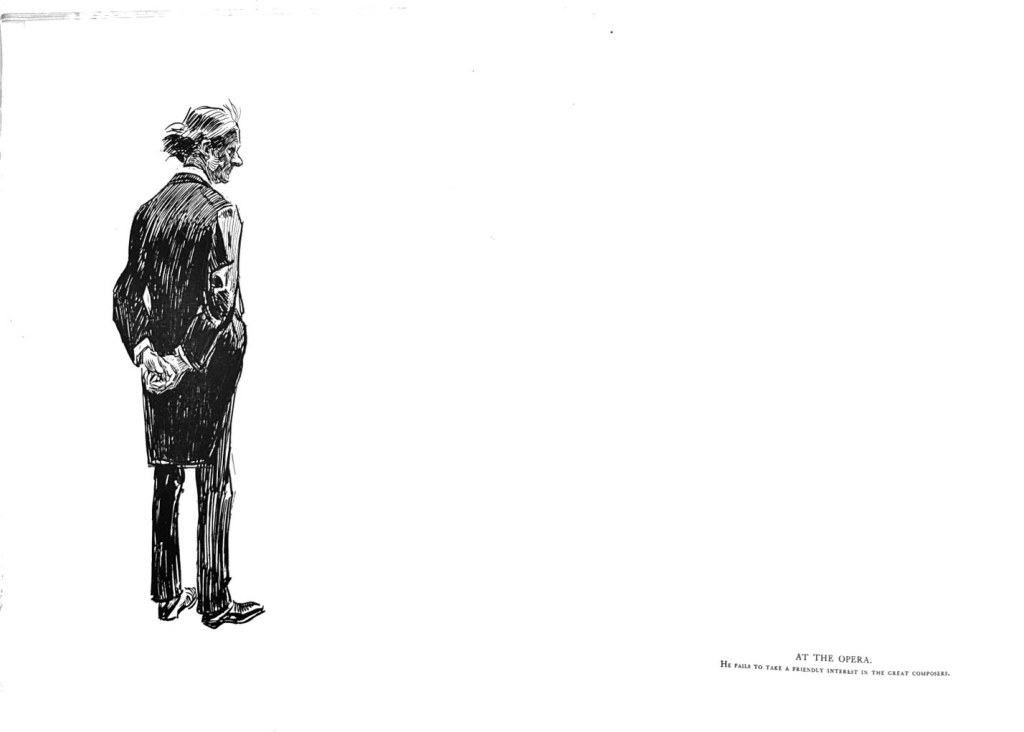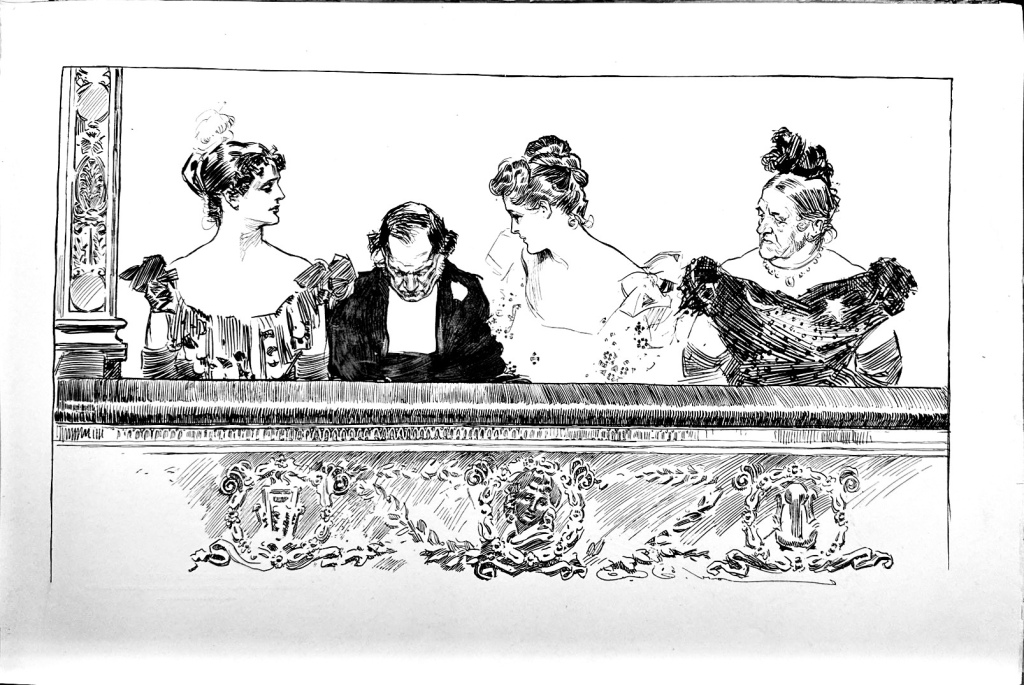
For comic strip devotees, Charles Dana Gibson (1867-1944) is often treated as a sidebar. And yet in the last decade of the 19th and first of the 20th Centuries he may have been the most famous and recognizable cartoonist in America. Best known for his “Gibson Girl” idealizations of middle class feminine youths, he worked mainly in Life and other humor and mass market magazines of the 1890s and 1910s. In fact after WWI Gibson became editor and eventually owner of Life. But by that point the newspaper revolution had diminished the power and role for weekly humor periodicals. This may be why both Gibson’s style and career seems at odds with the evolving comic strip. He represented the more gentle and genteel humor of a magazine world that sniffed at the crude humor and violence of the massively popular dailies.
Compared to the raucous multi-ethnic action of Mssrs. Dirks, Outcault and Opper, Gibson’s light caricature of parlor room denizens and oh-so-white, oh-so-privileged young lovers may seem tepid. But Gibson was precisely the cartoonist the American bourgeoisie wanted, a master of subtlety and understatement that pricked so gently at the repressions and pomposities of a rising middle class struggling towards propriety. All of the action in Gibson’s world is registered by subtle facial expressions, minor posture shifts, the small outward expressions of unspoken emotion.
Gibson’s formidable skills are clearest in his 1899 graphic novel, The Education of Mr. Pipp. The massive 17.25 x 11.75 inch R.H. Russell reprint compiles a monthly series of Life magazine center spreads he had drawn across 1898-99. This American-abroad story has businessman Pipp, his wife and young adult daughters traveling not only thorough Europe but also through every trope of Old World chicanery vs. New World innocence. Mrs. Pipp attaches herself to a “reduced nobleman” who flatters the wife and fleeces the husband. Meanwhile Mr. Pipp is courted by a widowed English lady. Amidst the marital jealousies and the touring, the Pipps barely notice that their daughters are themselves being pursued. The beauty in Gibson’s telling of a familiar tale is his highlighting the key emotional moments in these family dynamics with a pen line that so exquisitely expressed big feelings in small gestures. His tableaux stage his characters to express their emotional dynamics, and the tiniest facial

Gibson constructs Pipp as that most modern of sitcom fathers, the shrunken man. His matronly wife and daughter form a unified mass that dwarf the man in scale and resolve. His face suggests at once disapproval and resignation at the “suggestion” of a trip abroad. In the next scene, the girls become steadfast pillars on a rough sea, acting either as support for a seasick father or guards to a hostage. Hard to tell which it is.



Pipp’s paternal cluelessness (and so his path to “education”) is established across the first third of the journey. It becomes clear to the reader that the trip is all about the daughters and their larger social and marital ambitions. Within the constraints of late Victorian middle class propriety, Gibson finds ways to communicate romance and even sexual energy.

Pipp is among the first of the cartoon half-sized dads, a sitcom gallery that would soon include Jeff of Mutt and Jeff, E.P. Dingbat (Family Upstairs), Jiggs (Bringing Up Father), Barney Google AND Snuffy Smith, Paw (Polly and Her Pals), Pappy (Li’l Abner), among many others. From Gibson’s first panels he establishes poor Pipp visually as outnumbered, outsized and outgunned. In fact much of this (mis)adventure, and the source of its comedy, is Pipp struggling to assert his identity and will.
The enormous 1899 collection of Gibson’s Pipp series for Life uses its size artfully, with the main, detailed tableau of each stage of the story on the right page in immersive scale, and the left occupied by a mood-setting cameo image to the far edge of the page and the caption (often ironic) for the tableau. There is a wonderful sense of comic timing to the page by page progression across several different notes leading to the fully detailed story scene.






As the adventure deepens, so do the emotions. European types capture Mr. and Mrs. Pipp’s affections, and so jealousies develop. The “Gibson Girl” daughters attract the attention of “Gibson Men” who the artist depicts as just as much the spotlessly gorgeous and diffident representatives of the new middle class generation as his ladies. And this is where Gibson’s real talent for the nuance of facial expression really kicks in, where he surfaces an inner roiling emotion on the limited palette of facial expression allowed in polite society.
Whether it is showing Pipp struggling to look engaged at a dinner party, Mrs. Pipp scowling at a door awaiting her gallivanting husband’s return, the daughters playfully persuading their father, or the girls and their lovers anxiously awaiting Pipp’s approval of their marriage – it was all about the face. Gibson understood how in a world so stuck up on propriety, the exposed surface of the face was where drama occurred. This ewas quite different from much of early 20th Century newspaper cartooning, which generally moved from the proper parlor to outdoors, focused on the city street, physical action more than facial expressiveness. Gibson was drawing a social class on the verge of release from its own propriety. The newspaper strip was about that change, tre urban environment and diverse populations that defined that change.
In many ways, Gibson was a master of surfacing repressed feelings. The famed Gibson Girl could be wildly erotic in a fully misdirected way. Her cheeks were full and freshly youthful – even fecund. Her droopy eyes were at once disinterested and lustful – even post-coital. The figure she couldn’t show in her heavily corseted and neck-high attire was often projected onto that curvy burst of hair. At times, Gibson let those tresses bulge atop her head and at others flow down out of its upswept bun into a languid form that resembled a naked body down a girl’s shoulder. And while the “girl” figure was most famous, Gibson put great attention to their courtiers, the youthful, eager, romantically charged men who pursued them. Sexuality was the subtext. Gibson was illustrating a young generation and an American culture on the cusp of greater expressiveness and outward emotion – the world the newspaper comic strip would prove better able to caricature.


The erotic potential in Gibson’s Girls was made explicit when these drawings were repurposed as wallpaper, created and sold specifically for “bachelor apartments.”

A full scan of The Education of Mr. Pipp is available to view or download below in PDF form.




